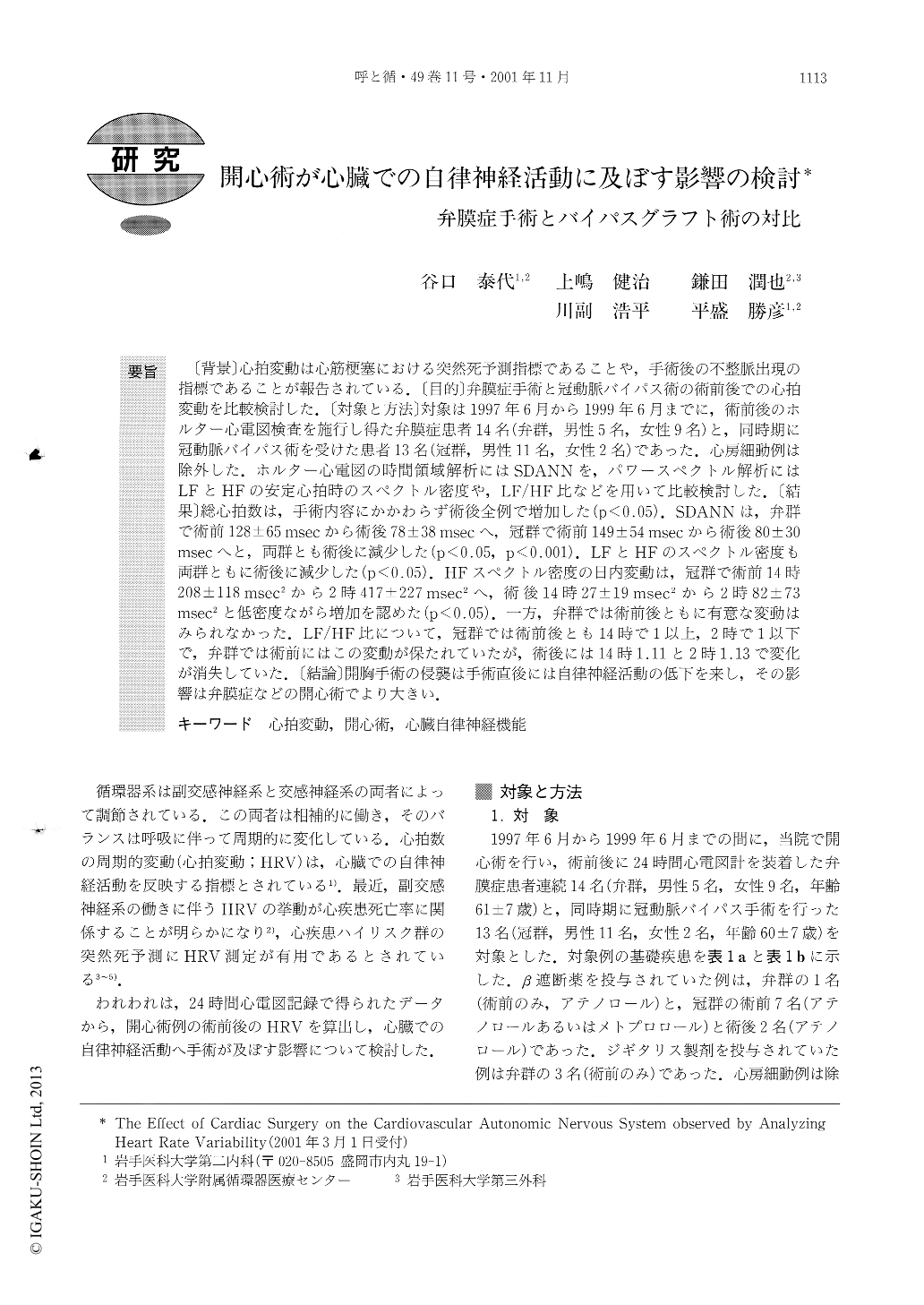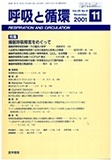Japanese
English
- 有料閲覧
- Abstract 文献概要
- 1ページ目 Look Inside
〔背景〕心拍変動は心筋梗塞における突然死予測指標であることや,手術後の不整脈出現の指標であることが報告されている.〔目的〕弁膜症手術と冠動脈バイパス術の術前後での心拍変動を比較検討した.〔対象と方法〕対象は1997年6月から1999年6月までに,術前後のホルター心電図検査を施行し得た弁膜症患者14名(弁群,男性5名,女性9名)と,同時期に冠動脈バイパス術を受けた患者13名(冠群,男性11名,女性2名)であった.心房細動例は除外した.ホルター心電図の時間領域解析にはSDANNを,パワースペクトル解析にはLFとHFの安定心拍時のスペクトル密度や,LF/HF比などを用いて比較検討した.〔結果〕総心拍数は,手術内容にかかわらず術後全例で増加した(p<0.05).SDANNは,弁群で術前128±65msecから術後78±38msecへ,冠群で術前149±54 msecから術後80±30msecへと,両群とも術後に減少した(p<0.05,p<0.001).LFとHFのスペクトル密度も両群ともに術後に減少した(p<0.05).HFスペクトル密度の日内変動は,冠群で術前14時208±118msec2から2時417±227 msec2へ,術後14時27±19msec2から2時82±73msec2と低密度ながら増加を認めた(p<0.05).一方,弁群では術前後ともに有意な変動はみられなかった.LF/HF比について,冠群では術前後とも14時で1以上,2時で1以下で,弁群では術前にはこの変動が保たれていたが,術後には14時1.11と2時1.13で変化が消失していた.〔結論〕開胸手術の侵襲は手術直後には自律神経活動の低下を来し,その影響は弁膜症などの開心術でより大きい.
Epidemiological evidence indicates that depressed baroreflex sensitivity and heart rate variability (HRV) are associated with cardiac events after open heart surgery (OHS) or acute myocardial infarction. The aimof this study was to verify the changes in the autonomic balance by means of HRV assessment in patients who underwent OHS. We studied 14 patients who underwent OHS for valvular heart disease with preserved left ventricular (LV) function (ejection fraction, EF 72± %) (valve group, 5 males, 9 females, mean age 61 ± 7) and an age-matched group of 13 patients (CABG group, 11 males, 2 females EF 63±7 %) who underwent coronary artery bypass graft surgery. Using 24-hour Holter ECG monitoring before and up to 2 weeks after OHS, the following parameters with time domain analysis and frequency analysis were examined at two separate times (at 2 p.m. and at 2 a.m.). No cardiac events occurred during hospital days. Before OHS, low frequency (LF) power of the valve group at 2 p.m. was lower than that of the CABG group. After OHS, total heart rate increased and standard deviation of mean RR intervals (SDANN) in the time domain analysis decreased in both groups. In the frequency analysis, LF and high frequency (HF), the power of both groups also decreased after OHS. The LF/HF ratio of the valve group was significantly lower than that of the CABG group after OHS (p <0.05) both at 2 p.m. and 2 a.m. Furthermore, the LF/HF ratio of the valve group at 2 a.m. was over 1 and after OHS the circardian rhythm of heart rate variability was diminished in the valve group. Although OHS improved the circulatory blood flow system, the autonomic nervous system was suppressed immediately after surgery. Furthermore, vasomotor and cardiac autonomic tone after OHS may become depressed more significantly in valvular heart disease. Closed physiological observation might be needed after OHS for patients with valvular heart disease.

Copyright © 2001, Igaku-Shoin Ltd. All rights reserved.


